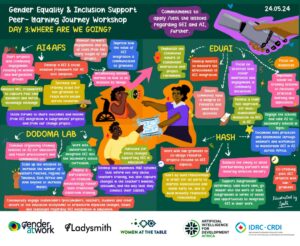Based on a conversation with Sudarsana Kundu and Carol Miller
by Aayushi Aggarwal and Atlas Portal
Women in leadership positions
Despite some progress in the workplace in the last few years, gender stereotypes are still entrenched in our societies and workplaces. Gender norms, stereotypes and socio-cultural practises can still be very restrictive for women’s participation in the workplace. Currently, women make up less than 10% of executive directorships in FTSE100 companies. Research shows that for women to aspire to rise to leadership positions, role models are vital.
Showing up for each other
Role models matter, particularly for women. due to the gender biases, institutional barriers and negative stereotypes they have had to contend with in their personal, social and professional lives.
Past research has shown that female role models, particularly in male-dominated professions and sectors such as STEM, assist in improving women’s recruitment, retention by creating a sense of belonging, providing a clear path of progression, and dispelling myths around women’s leadership and performance. They help create the space for others to enter the pipeline. Exposure to female role models has increased female students’ enrolment and completion of studies in specific subject areas, in particular in the math-intensive fields of ‘hard’ sciences, engineering, economics, arithmetic.
Seeing is believing
Female role models can signal to young women that it is possible to succeed in different domains of work, especially in leadership roles. Even today, there are deep-seated gender biases against women’s leadership. For instance, data from the Reykjavik Index for leadership, indicate that significantly fewer people believe that women are equally suited as men in leadership positions. Within the corporate sphere, the visible presence of women at senior levels challenge the stereotype that male managers are more suitable for leadership positions than female managers, therefore facilitating the advance of more women in organizations.
In short, seeing is believing.
Still – a glass ceiling
Despite the notable out-performance of female-led organizations, as noted by McKinsey, progress on gender equality and gender parity at a workplace has stalled or even regressed in many countries across the world. Less than half (47.3%) of all women participated in the labour force in 2019, a decrease from 51.0% in 1990. While most organizations speak of their commitment to gender diversity, equity and equality, that commitment has for most not yet translated into progress. A glass ceiling still hinders women’s advancement in the workplace. This hindrance has only been exacerbated by the COVID-19 crisis. While the pandemic has been the cause of a massive increase in unemployment globally, women in particular have been negatively impacted. Women—especially women of colour—are more likely to have been laid off, stalling their careers and jeopardizing their financial security.
Women aspiring to leadership roles
Nonetheless, the number of women sitting on boards of Fortune 500 companies in the US has more than doubled from 9.6 per cent in 1995 to 22.2% in 2017 ( Pew Research 2017).
We have also seen the gender parity gap in the workplace improve in some countries. A few underlying reasons contribute to these improvements. Firstly, women’s labour force participation can get a boost from government policies that promote educational enrolment of girls and specific family-friendly labour policies, such as state-subsidised childcare or job-protected leave entitlements. Across the world, women’s educational attainment levels have improved dramatically, so much so that a Pew Research Centre Survey finds that “today’s young women are starting their careers better educated than their male counterparts.” Similarly, many countries have instituted quotas for female representation on corporate boards. Corporate America scores much lower than France or Norway, where businesses average more than 40% female representation on a board of directors.
While these quotas have improved board diversity, they have not necessarily translated into greater women’s representation at senior management levels. To ensure a sustainable change in the presence of women in leadership, the organizational culture has to change towards women’s leadership being considered equal to that of men’s. Such change would also entail that there are active measures to challenge gender norms and stereotypes.
Organisational structures and cultures
As we have mentioned earlier, a lot more needs to be done to increase the number of women in leadership roles. Not only do we need family-friendly policies at the workplace that recognise that women bear a disproportionate share of care responsibilities at home, but organizations also need to put in place recruitment and promotion policies that target women’s underrepresentation and gender bias in hiring. Organizations need to ensure a sufficient pipeline of women who can rise up the ranks and reach the C-Suite levels.
More importantly, as research on organizational cultures has shown, patriarchal norms hinder women from accessing opportunities for career progression or being valued for their leadership. The slow pace of change in the number of women in leadership roles is related to issues of organizational culture, of deeply embedded patriarchal notions of leadership attributes that have become normalised.
Repeated studies have shown that women often feel invisible at work and their ideas and contributions get unrecognised. Organizations continue to reward, recognise achievement, provide incentives and promote employees using a leadership assessment framework based on a male-centric style of leadership. To shift the ‘deep structure’ of organizations through which gender discriminatory norms and power relations are reproduced, organizations have to look beyond superficial quick fixes such as mission statements, codes of conduct or diversity training and embrace the tougher work of change the organizational culture through acceptance and encouragement of women’s leadership attributes; promotion of values of equality within both formal policies and informal practices of the organization, acknowledgement of the care burden and creating an incentive structure that rewards initiatives on gender equality.
Atlas Portal is currently working as research and communications intern with Gender at Work and Aayushi Aggarwal is the communications manager at Gender at Work.
Sign up for our newsletter and stay up-to-date with notifications about our new blog pieces.
[contact-form-7 id=”25436″ title=”Subscribe (Blog)”]




